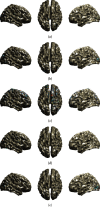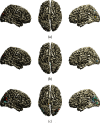A Novel Bayesian Approach for EEG Source Localization
- PMID: 33178259
- PMCID: PMC7647781
- DOI: 10.1155/2020/8837954
A Novel Bayesian Approach for EEG Source Localization
Abstract
We propose a new method for EEG source localization. An efficient solution to this problem requires choosing an appropriate regularization term in order to constraint the original problem. In our work, we adopt the Bayesian framework to place constraints; hence, the regularization term is closely connected to the prior distribution. More specifically, we propose a new sparse prior for the localization of EEG sources. The proposed prior distribution has sparse properties favoring focal EEG sources. In order to obtain an efficient algorithm, we use the variational Bayesian (VB) framework which provides us with a tractable iterative algorithm of closed-form equations. Additionally, we provide extensions of our method in cases where we observe group structures and spatially extended EEG sources. We have performed experiments using synthetic EEG data and real EEG data from three publicly available datasets. The real EEG data are produced due to the presentation of auditory and visual stimulus. We compare the proposed method with well-known approaches of EEG source localization and the results have shown that our method presents state-of-the-art performance, especially in cases where we expect few activated brain regions. The proposed method can effectively detect EEG sources in various circumstances. Overall, the proposed sparse prior for EEG source localization results in more accurate localization of EEG sources than state-of-the-art approaches.
Copyright © 2020 Vangelis P. Oikonomou and Ioannis Kompatsiaris.
Conflict of interest statement
The authors declare that they have no conflicts of interest.
Figures






Similar articles
-
Bayesian EEG source localization using a structured sparsity prior.Neuroimage. 2017 Jan 1;144(Pt A):142-152. doi: 10.1016/j.neuroimage.2016.08.064. Epub 2016 Sep 15. Neuroimage. 2017. PMID: 27639353
-
Bayesian Algorithm Based Localization of EEG Recorded Electromagnetic Brain Activity.Curr Med Imaging Rev. 2019;15(2):184-193. doi: 10.2174/1573405613666170629112918. Curr Med Imaging Rev. 2019. PMID: 31975664
-
Effects of fMRI-EEG mismatches in cortical current density estimation integrating fMRI and EEG: a simulation study.Clin Neurophysiol. 2006 Jul;117(7):1610-22. doi: 10.1016/j.clinph.2006.03.031. Epub 2006 Jun 9. Clin Neurophysiol. 2006. PMID: 16765085 Free PMC article.
-
Fast and robust Block-Sparse Bayesian learning for EEG source imaging.Neuroimage. 2018 Jul 1;174:449-462. doi: 10.1016/j.neuroimage.2018.03.048. Epub 2018 Mar 27. Neuroimage. 2018. PMID: 29596978
-
Sparse algorithms for EEG source localization.Med Biol Eng Comput. 2021 Nov;59(11-12):2325-2352. doi: 10.1007/s11517-021-02444-5. Epub 2021 Oct 2. Med Biol Eng Comput. 2021. PMID: 34601662 Review.
Cited by
-
Structured noise champagne: an empirical Bayesian algorithm for electromagnetic brain imaging with structured noise.Front Hum Neurosci. 2025 Apr 7;19:1386275. doi: 10.3389/fnhum.2025.1386275. eCollection 2025. Front Hum Neurosci. 2025. PMID: 40260174 Free PMC article.
-
High-Resolution EEG Source Reconstruction from PCA-Corrected BEM-FMM Reciprocal Basis Funcions: A Study with Visual Evoked Potentials from Intermittent Photic Stimulation.bioRxiv [Preprint]. 2025 Jul 16:2025.07.11.664246. doi: 10.1101/2025.07.11.664246. bioRxiv. 2025. PMID: 40791388 Free PMC article. Preprint.
References
-
- Liu S., Cao R., Huang Y., Ouypornkochagorn T., Ji J. Time sequence learning for electrical impedance tomography using bayesian spatiotemporal priors. IEEE Transactions on Instrumentation and Measurement. 2020;69(9):6045–6057. doi: 10.1109/tim.2020.2972172. - DOI
-
- Liu S., Huang Y., Wu H., Tan C., Jia J. Efficient multi-task structure-aware sparse bayesian learning for frequency-difference electrical impedance tomography. IEEE Transactions on Industrial Informatics. 2020;20:p. 1.
-
- Sekihara K., Nagarajan S. S. Electromagnetic Brain Imaging - A Bayesian Perspective. Berlin, Germany: Springer; 2015.
MeSH terms
LinkOut - more resources
Full Text Sources

